Method of operating an internal combustion engine
a technology of internal combustion engine and working process, which is applied in the direction of combustion engine, machine/engine, mechanical apparatus, etc., can solve the problems of negative effects of longer cycle times, negative effects on emissions, and insufficient exhaust temperature, so as to achieve the lowest possible emissions, low loss of charge exchange, and high consumption potential
- Summary
- Abstract
- Description
- Claims
- Application Information
AI Technical Summary
Benefits of technology
Problems solved by technology
Method used
Image
Examples
Embodiment Construction
[0031] The FIGURE shows the valve lifts h of the exhaust valves and of the intake valves, the exhaust valve lift being indicated at 1 and the intake valve lift at 2.
[0032] Line 3 shows the injection events in the combustion chamber.
[0033] In the lower part of the diagram, the cylinder pressure p is plotted down the side thereof whereas the crank angle KW is plotted on the horizontal axis. This curve is indicated at 4.
[0034] The working method is comprised of six strokes I, II, III, IV, V, VI, two strokes pertaining to a respective one of a cycle A, B, C. The first cycle A serves for gas exchange and consists of stroke VI for exhaust expulsion and of stroke I for air intake. The second cycle B consists of stroke II during which the air is compressed inside the cylinder and a first fraction of gasoline fuel is injected and of stroke III, the first working stroke of the piston. At the end of stroke II, the first fraction of gasoline fuel is injected as indicated at 3a. Thereupon, at th...
PUM
 Login to View More
Login to View More Abstract
Description
Claims
Application Information
 Login to View More
Login to View More - R&D Engineer
- R&D Manager
- IP Professional
- Industry Leading Data Capabilities
- Powerful AI technology
- Patent DNA Extraction
Browse by: Latest US Patents, China's latest patents, Technical Efficacy Thesaurus, Application Domain, Technology Topic, Popular Technical Reports.
© 2024 PatSnap. All rights reserved.Legal|Privacy policy|Modern Slavery Act Transparency Statement|Sitemap|About US| Contact US: help@patsnap.com









